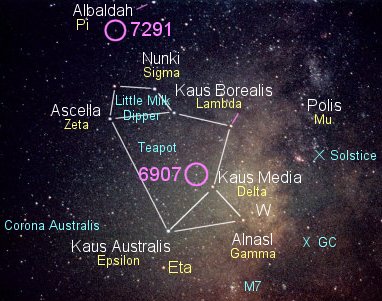 The circle shows the location of the class F star HR 6907, found in
the constellation Sagittarius. The star
is orbited by two planets, a smaller one closer to the star and a
larger one farther away that make it look vaguely like our own
system (though both are considerably more massive than Jupiter).
The circle shows the location of the class F star HR 6907, found in
the constellation Sagittarius. The star
is orbited by two planets, a smaller one closer to the star and a
larger one farther away that make it look vaguely like our own
system (though both are considerably more massive than Jupiter).
THE PLANETS
*Planet 1: From the star outward, planet 1 orbits in 225.62 days, has a mass at least 2.88 times that of Jupiter, and is 0.81 Astronomical Units (AU) from the star (121 million kilometers, 75 million miles), that is, 81 percent the size of Earth's orbit. Orbital eccentricity takes the planet from 1.06 to 0.56 AU and back again.*Planet 2 takes 5.76 years to orbit. It has a mass at least 4.04 times that of Jupiter, and averages 3.60 Astronomical Units from the star (540 million kilometers, 335 million miles, or 69 percent the size of Jupiter's orbit). The orbital eccentricity is oddly almost the same as that of planet 1's orbit, planet 2 ranging between 2.4 and 4.8 AU.